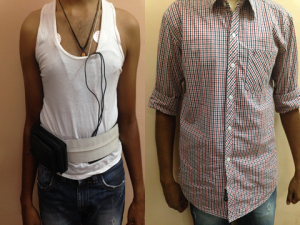Real Time Wearable Cardiac Monitoring
Project Guide : Dr. N Sriraam ,Head ,Medical Electronics,MSRIT,Chair,EMB Bangalore Chapter, Staff Advisor,IEEE MSRIT SIGHT
Project Members:
Jishin Jayrajan,-Satya Prakash Mishra,-Savithru Goutham N,-Vishwajit Palsule,Final Year Medical Electronics,MSRIT
 With the technology being growing very fast, there is a huge demand towards developing cost effective healthcare delivery especially for rural India. Every year around 32 million patients suffer from some types of cardiac diseases in our country, with this huge number (almost the population of Canada), cardiac care is one of the most busiest medical specialties in India. A group of final year medical electronics students of MSRIT in association with the M.S.Ramaiah Hospitals under the guidance of Dr N.Sriraam(MSRIT) and Dr Nagamalesh(MSRMH) have come with a novel prototype on real-time wearable belt for continuous monitoring of cardiac (ECG) signals from the heart. With this device,especially the old people can wear and do their day today routine where their ECG is monitored continuously. Whenever the person feels any chest pains or giddiness, the corresponding ECG recording will be transmitted immediately, which can be viewed by the doctor from anywhere . Further the system will also convey the type of arrhythmia so that attendant can take the necessary step at that point.
With the technology being growing very fast, there is a huge demand towards developing cost effective healthcare delivery especially for rural India. Every year around 32 million patients suffer from some types of cardiac diseases in our country, with this huge number (almost the population of Canada), cardiac care is one of the most busiest medical specialties in India. A group of final year medical electronics students of MSRIT in association with the M.S.Ramaiah Hospitals under the guidance of Dr N.Sriraam(MSRIT) and Dr Nagamalesh(MSRMH) have come with a novel prototype on real-time wearable belt for continuous monitoring of cardiac (ECG) signals from the heart. With this device,especially the old people can wear and do their day today routine where their ECG is monitored continuously. Whenever the person feels any chest pains or giddiness, the corresponding ECG recording will be transmitted immediately, which can be viewed by the doctor from anywhere . Further the system will also convey the type of arrhythmia so that attendant can take the necessary step at that point.
This project was supported by MSRIT Internal funding scheme and IEEE MSRIT SIGHT

DESIGNED WEARABE CARDIAC BELT
STUDY AND INVESTIGATION OF SMARTPHONE IMAGING OF THE EYE
Project Guide (Internal) : Dr. N Sriraam , Head ,Medical Electronics,MSRIT,Chair,EMB Bangalore Chapter, Staff Advisor,IEEE MSRIT SIGHT
Project Guide (External): Dr. Mahesh Shanmugham ,Head, Vitreoretinal & Ocular Oncology Services, Sankara Eye Hospital, Bangalore
Dr. Divyansh Mishra, Retina Fellow, Sankara Eye Hospital, Bangalore
Project Members:
Deepak S ,Shashank Rao ,Darshan M C ,Final Year Medical Electronics,MSRIT
Globally the number of people of all ages visually impaired is estimated to be 285 million, of whom 39 million are blind and the number is increasing. Nearly 75% of these visual impairments can be cured if, timely diagnosis is done. Existing eye care tools are expensive, not portable, difficult to use and access. People don’t get treated quickly enough, or at all. Patients in rural areas lack the financial means to undergo regular eye examinations and rural ophthalmologists do not possess expensive equipments to diagnose their patients. As a tool for diagnosis the smartphone camera and lens adapter arrangement can be used as an affordable, easy to use and portable system for testing eyes. The device could replace the existing expensive eye screening equipments when only early screening of eye diseases and basic regular fundus examinations are required. Being a battery operated device, it could be used in thousands of villages with no power supply
This project was supported by MSRIT Internal funding scheme and IEEE MSRIT SIGHT


